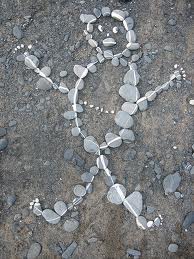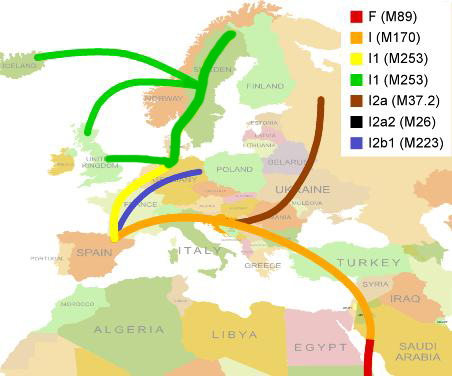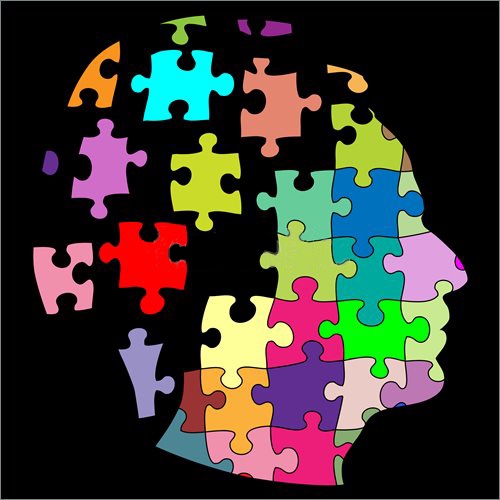|
|
Y-DNA testing yields two types of results, this page is about one type of those results.
OUR ANCIENT HISTORICAL PROFILE - Our Haplogroup

![]() All male humans alive today can be classified into a specific Y-DNA Haplogroup within the Y-DNA Haplotree, based on SNP[1] markers found in their Y-DNA. Having studied SNPs from indigenous individuals from around the world (living or otherwise), scientists can estimate the time and location each SNP first occurred. Once the time and location of occurrence of the SNP mutation is known, it becomes a "time and date stamp" which can be used to trace ancestral clusters and migrations.
All male humans alive today can be classified into a specific Y-DNA Haplogroup within the Y-DNA Haplotree, based on SNP[1] markers found in their Y-DNA. Having studied SNPs from indigenous individuals from around the world (living or otherwise), scientists can estimate the time and location each SNP first occurred. Once the time and location of occurrence of the SNP mutation is known, it becomes a "time and date stamp" which can be used to trace ancestral clusters and migrations.
Human Y-DNA Haplogroups are named using the letters of the alphabet, A to T. Each Y-DNA Haplogroup is then further sub-classified into newer groups (branches) called subclades, when those people of any particular group develops their own change (mutation). This in turn, is then part of any new subsequent generation and seems to occur every several thousand years, or so, since the beginning of time. These "subclades" are also named using letters and numbers. This is usually expressed as a number proceeded by a letter. For example, the mutation identifier "Z58" means a mutation at marker "Z58", not previously seen. These mutations, and the resulting population, is not a new Haplogroup, but rather a subgroup (branch), within the overall haplogroup. Therefore, each Haplogroup usually contains many distinct families with similar, although not exact, YDNA profiles. Some subgroups are deemed more important than others, based on how many people (and further subclades) that particular branch eventually contains. If this sounds confusing, think of a river and how that can constantly mutate when different branches develop, starting as new streams at various points, some succeeding and some not. The "magic" of all this, pertaining to genealogy, occurs because these 'mutations' are not overwritten and remain as part of each person's Y-DNA chromosome and can be seen and used as evidence for genealogical comparisons and anthropological analysis. So, to be clear, a persons actual proper "Haplogroup" is a long string of numbers containing ALL of the subclades, going all the way back to the beginning of time. Any point where two (or more) tests differ, is that point in time when the two tests/families took different subsequent paths.
These ever evolving subclade discoveries are the most important change and focus of genetic genealogy, mostly coming into use only since the most recent millennium. The understanding and growth of what we know about this has been exponential. It has also caused considerable confusion, as is anything new where constant discoveries change classifications and nomenclature. It is some time difficult to keep up with all of this and frequently confusing.

![]() We know from YDNA testing that our particular Jameson family all fall into a general grouping known as Haplogroup "I" (eye) with a early important subclade (mutation) identified at "M253," often referred to as I-M253. That Haplogroup was itself an offshoot, or subclade of Haplogroup "I" with a mutation "M170." Before that it is believed our Haplogroup was "F" mutation "M89" which itself was derived from Haplogroup "CT" mutation identified at "M168." It is from here researchers think "Eurasian Adam" may have been our oldest common, ancestor, who was thought to be alive some 31,000 to 79,000 years ago in Africa.
We know from YDNA testing that our particular Jameson family all fall into a general grouping known as Haplogroup "I" (eye) with a early important subclade (mutation) identified at "M253," often referred to as I-M253. That Haplogroup was itself an offshoot, or subclade of Haplogroup "I" with a mutation "M170." Before that it is believed our Haplogroup was "F" mutation "M89" which itself was derived from Haplogroup "CT" mutation identified at "M168." It is from here researchers think "Eurasian Adam" may have been our oldest common, ancestor, who was thought to be alive some 31,000 to 79,000 years ago in Africa.
Haplogroup I-M253 (and therefore our particular Jameson family) is somewhat of a lesser player worldwide, as far as size goes, considerably smaller than other groups such as the "R" Haplogroup. It is however a major player in Europe, particularly northern Europe, where it is fairly widespread. Nevertheless, our group, "I," like all others, has it's beginnings on the African continent, maybe 50,000 years ago, or longer.
Some claim that our group within the group (I-M253) would first be found in the Iberian Refugia (Spain), some 15,000 to 20,000 years ago, during the last ice age. Migration patterns, after the ice finally began its slow retreat, show a northern movement through France and then on to a northeastern loop into what is now Germany and Denmark, then into all of Scandinavia Interestingly this migration loop continued from northeastern Europe and Scandinavia westward, back into the British Isles.
Noted Haplogroup I1 specialist, Professor Ken Nordtvedt, believes the most recent common ancestor (MRCA) lived from 4,000 to 6,000 years ago somewhere in the far northern part of Europe, perhaps Denmark. Therefore our particular M253 (mutated) ancestors were not as old as originally thought. Subsequent migration and settlement data however doesn't seem to be in dispute.
I-M253 et al, has it's greatest frequency and density in Scandinavia, Iceland, and northern Europe. In Britain, this nomenclature is sometimes referred to as an identifier for "invaders," Mostly this means the Anglo-Saxon, but would probably also apply to the Vikings, especially in northern England and in Scotland.
| Test ID | Pedigree to Common Ancestor | |||||||||||||||||||||||||||||
|---|---|---|---|---|---|---|---|---|---|---|---|---|---|---|---|---|---|---|---|---|---|---|---|---|---|---|---|---|---|---|
| H a p l o |
Significant SNPs - oldest to newest (Terminal SNP) |
|||||||||||||||||||||||||||||
| Family Branch: Hugh Jameson (1713-1790) - Ire/NH | ||||||||||||||||||||||||||||||
| 88227 - |
Hugh\Alexander\Daniel | I | M170 | Z2699 | Z840 | M253 | DF29 | Z58 | Z138 | S2293 | S6277 | FGC41670 | S6270 | S20289 | A6397 | BY34656 | FT18664 | FTE33014 | + | |||||||||||
| 185066 - |
Hugh\Daniel\Jonas | I | M170 | Z2699 | Z840 | M253 | DF29 | Z58 | Z138 | |||||||||||||||||||||
| 195455 - |
Hugh\Hugh\Hugh | I | M170 | Z2699 | Z840 | M253 | DF29 | Z58 | Z138 | |||||||||||||||||||||
| Family Branch: Thomas Jameson (1710-1764) - Ire/NH | ||||||||||||||||||||||||||||||
| 201202 - |
Thomas\John\Robert | I | M170 | Z2699 | Z840 | M253 | DF29 | Z58 | Z138 | |||||||||||||||||||||
| 979509 - |
Thomas\Thomas\James | I | M170 | Z2699 | Z840 | M253 | DF29 | Z58 | Z138 | |||||||||||||||||||||
| 178784* - |
Thomas\Alexander\Thomas | I | M170 | Z2699 | Z840 | M253 | DF29 | Y2592 | CTS6364 | CTS10028 | A8200 | |||||||||||||||||||
| 284596* - |
Thomas\Alexander\Thomas | I | M170 | Z2699 | Z840 | M253 | DF29 | Y2592 | CTS6364 | CTS10028 | A8200 | |||||||||||||||||||
| Family Branch: William Jameson (1816-18??) - Ire/PA | ||||||||||||||||||||||||||||||
| 816905 - |
William\Jonathan\William | I | M170 | Z2699 | Z840 | M253 | DF29 | Z58 | Z138 | |||||||||||||||||||||
|
|
||||||||||||||||||||||||||||||
| * There is a question of paternal lineage regarding this test - see here for explanation | ||||||||||||||||||||||||||||||
| * Note on the color coding : Green = tested and confirmed; Orange = predicted (not yet specifically tested). | ||||||||||||||||||||||||||||||
Extended SNP testing within various branches of our particular Jam?son family reveals a positive existence at subclade SNP DF29, where after some in our extended Jameson family split (mutated genetically) into two different groups (branches), maybe 4,600 years ago, way before anybody was using the surname Jameson. Particulars of this split can be found here. It is interesting, that somehow these two families eventually (miraculously?) reformed into the same family hundreds, maybe thousands of generations later, probably by sheer coincidence, their original connections most likely unknown to each other, yet ending up part of the same family again, using the same surname.
One extended (Big-Y) test (#88227), on one side of the family, shows a SNP path which includes positives at subclade SNPs: Z58 and Z139, thought to have been formed about 4,000 years ago in the Nordic Bronze Age and early Germanic Iron Age expansion. This would then be almost certainly true also of tests: 185066, 195455, 201202 and 816905. The Big-Y test has also determined even more recent SNP subclade categorizing, including a new SNP, "BY34656," with 16 or more, of it's own, yet to be named (2019), possible subgroups. The BY34656 subclade is thought to be about 2,200 years old and it's apparent subgroups probably even somewhat more recent, putting what is known about part of this family into modern times. It can be assumed this is also true of everyone else on this same side of the family.
It is impossible to know exactly when or from where our ancestors first arrived in the British Isles. It was most likely by way of the Vikings from Scandinavia, as early as the latter part of the ninth or tenth century. It could have been the Anglo Saxon invasion of Britain in the fourth of fifth century, or perhaps from northern France at the time of the Norman Conquest. It is however safe to say they were certainly in Scotland before the time of surnames, in the twelfth or thirteenth century. Long enough ago to now be considered as an integral and structural part of that ethnicity.
![]() - Click here for our New Hampshire Jameson genetic DYS marker test results and Y-DNA Profile.
- Click here for our New Hampshire Jameson genetic DYS marker test results and Y-DNA Profile.

![]() In the last few years DNA testing for use with researching family histories and genealogy, has become widely available, affordable and as such a unique and important toot. There are now several very reputable labs who do this specifically for genealogy as well as groups who have organized for unique family projects.
In the last few years DNA testing for use with researching family histories and genealogy, has become widely available, affordable and as such a unique and important toot. There are now several very reputable labs who do this specifically for genealogy as well as groups who have organized for unique family projects.
We test for the Y Chromosone and use the Family Tree DNA - Genealogy by Genetics, Ltd. company.This type of DNA testing helps us understand and focus on the patriarchal nature and family grouping of our specific Jameson family. We are part of several DNA Projects including: The Jameson Family DNA Project, the Gunn Sept List DNA Project, the Clan Stewart DNA Project, the Ulster (Ireland) Heritage DNA Project, the Scotland DNA Project, and the Haplogroup I1 Project.
We urge every Jameson male descendant (must have the Jameson surname) to help find your own ancestors with this DNA program. Please read this page of answers about DNA testing and then contact us about how to coordinate your results.
![]() - for information on how to get started.
- for information on how to get started.
| [1] | SNP is an acronym for "Single Nucleotide Polymorphism" a scientific term used to identify a series of long term (thousands of years) markers in DNA testing and analysis, usually for the purpose of determining a Halpogroup. |